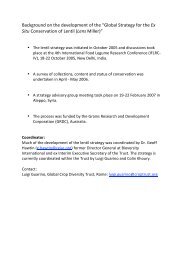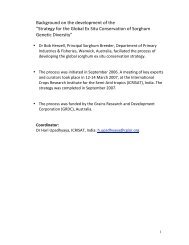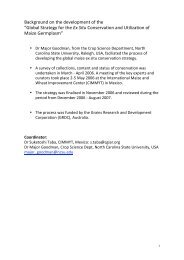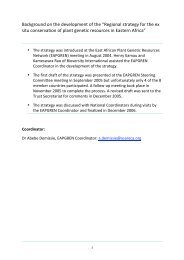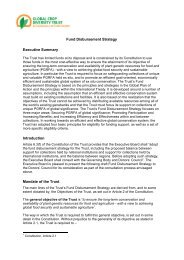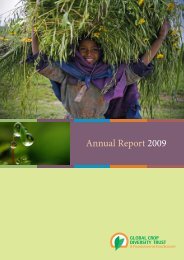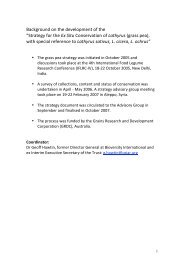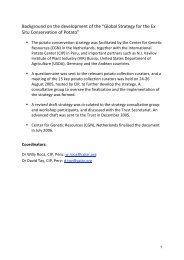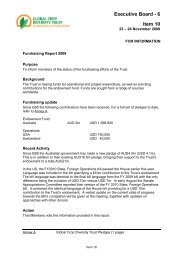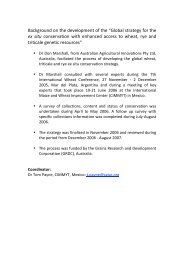Safeguarding the Future of US Agriculture - Global Crop Diversity Trust
Safeguarding the Future of US Agriculture - Global Crop Diversity Trust
Safeguarding the Future of US Agriculture - Global Crop Diversity Trust
Create successful ePaper yourself
Turn your PDF publications into a flip-book with our unique Google optimized e-Paper software.
YES, We Have Bananas, and Plaintains Toobox 2DESPITE ITS great popularity,<strong>the</strong> banana teeters on <strong>the</strong>edge <strong>of</strong> disaster. Maintainingand making use <strong>of</strong> geneticdiversity in <strong>the</strong> bananaplant family will be key toits survival.Most people in <strong>the</strong> <strong>US</strong> know<strong>the</strong> banana commonlyavailable in grocery stores,but what <strong>the</strong>y do not knowis that <strong>the</strong>se bananas aremostly imported from LatinAmerica, are a singlevariety–Cavendish, and aresusceptible to severaldiseases, especially blacksigatoka to which Cavendishis susceptible, requiringabout 50 applications <strong>of</strong>fungicide each year toharvest a healthy crop. Incontrast, approximately 500different types <strong>of</strong> bananasare grown locally in <strong>the</strong>tropics. Some are sweettasting,dessert-types thatcan be eaten fresh. O<strong>the</strong>rs,like plantains, are starchierand need to be cookedbefore consumption.Bananas and plantains arestaple foods in many parts<strong>of</strong> <strong>the</strong> developing world,where genetic diversityabounds, but yields are lowand varietal improvementfor increased production isessential. Since <strong>the</strong>introduction <strong>of</strong> new varietiesmay eliminate nativediversity, collection <strong>of</strong> nativetypes must be conserved ingenebanks in all <strong>of</strong> <strong>the</strong>banana and plantaingrowingcountries. This is<strong>the</strong> key to long-termsustainability <strong>of</strong> <strong>the</strong>se foodcrops. Cultivated bananasand plantains, being sterileand producing no seeds,are generally maintained asliving plants growing in <strong>the</strong>field or in small bottles astissue culture.Plantation-grown bananas for<strong>US</strong> consumption are usuallysprayed with fungicide byairplanes, putting localpeople at risk from spraydrift. Breeding diseaseresistant varietiescomparable to <strong>the</strong> Cavendishshould be a high priority for<strong>the</strong> banana industry. Besidesblack sigatoka, <strong>the</strong> rootattackingdisease, fusariumwilt is re-emerging as aproduction threat. Fusariuminfects <strong>the</strong> plant’s roots,causing <strong>the</strong> trees to wiltand die. In <strong>the</strong> 1940s and1950s, a related strain <strong>of</strong>Fusarium nearly wiped out<strong>the</strong> <strong>the</strong>n-reigning king <strong>of</strong>exports, a banana varietycalled Gros Michel. If <strong>the</strong>new fungal strain spreadsfrom Asia, <strong>the</strong> Cavendishbanana may suffer <strong>the</strong>same fate as itspredecessor.Banana poses seriousproblems for plant breedersbecause <strong>of</strong> <strong>the</strong> difficulty <strong>of</strong>identifying stable, butsterile, plants forcommercialization.Biotechnology <strong>of</strong>fers goodsolutions to transfer genetictraits more efficiently fromone banana type to ano<strong>the</strong>r.Ultimately, success willdepend on <strong>the</strong> depth <strong>of</strong> <strong>the</strong>banana gene pool. Geneticdiversity, or lack <strong>the</strong>re<strong>of</strong>,could determine <strong>the</strong>continued viability <strong>of</strong>bananas both as a majorexport crop and as a criticalsource <strong>of</strong> nutritious food in<strong>the</strong> developing world.Items like <strong>the</strong>se papaya’s,rarely seen on a groceryshelf 20 years ago, arenow widely available asconsumers diversify <strong>the</strong>irfood choices and demandhealthier products. <strong>Crop</strong>diversity can provide <strong>the</strong>neccessary resources tomeet <strong>the</strong> demand forhealthier, high qualityproducts.© <strong>US</strong>DA-ARS, Scott Bauerwhen <strong>the</strong>re is no <strong>US</strong> production have been welcomed by consumers, who arewilling to pay a higher price. This <strong>of</strong>fers greater diversity in diets—a healthfulconsequence— and also provides ano<strong>the</strong>r example <strong>of</strong> how conserving <strong>the</strong> geneticdiversity <strong>of</strong> crops in foreign lands would benefit <strong>US</strong> consumers.The ERS anticipates that rising incomes will continue to allow Americans toupgrade and diversify <strong>the</strong>ir food choices. Economists project that food expenditureswill be 26 percent higher in 2020 compared to 2000, based on higher incomescombined with a larger population, with much <strong>of</strong> that growth attributed toimmigration. The <strong>US</strong> population is expected to grow by 18-28 percent, or 50-80million people, by 2020. This expenditure increase will have greater implicationsfor issues <strong>of</strong> quality than quantity, with items such as exotic fruits, mini vegetables,t<strong>of</strong>u-grade soybeans and vine-ripened tomatoes on consumers’ shopping lists.The trend toward healthier eating is also being fueled by nationwide worries aboutobesity. With approximately nine million children over <strong>the</strong> age <strong>of</strong> six now obese,parents are looking for alternatives to fast foods and soda pops. So pronounced isthis trend that <strong>the</strong> fast food industry is even <strong>of</strong>fering options: last October, forexample, McDonald’s introduced a new McVeggie Burger, a meatless, soy-basedpatty, and Wendy’s advertises a dish <strong>of</strong> miniature orange slices, in place <strong>of</strong> Frenchfries.22 CROP DIVERSITY, DIET AND CHOICE




